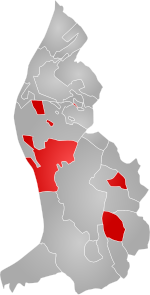Vaduz, Liechtenstein
| Vaduz | |||
|---|---|---|---|
| Municipality | |||

Vaduz
|
|||
|
|||
 Vaduz and its exclaves in Liechtenstein |
|||
| Coordinates: 47°08′28″N 9°31′16″E / 47.141°N 9.521°ECoordinates: 47°08′28″N 9°31′16″E / 47.141°N 9.521°E | |||
| Country |
|
||
| Electoral district | Oberland | ||
| Villages | Ebenholz | ||
| Government | |||
| • Mayor | Ewald Ospelt | ||
| Area | |||
| • Total | 17.3 km2 (6.7 sq mi) | ||
| Elevation | 455 m (1,493 ft) | ||
| Population (30-6-2015) | |||
| • Total | 5,429 | ||
| • Density | 288/km2 (750/sq mi) | ||
| Time zone | CET (UTC+1) | ||
| • Summer (DST) | CEST (UTC+2) | ||
| Postal code | 9490 | ||
| Area code(s) | 7001 | ||
| ISO 3166 code | LI-11 | ||
| Website | www.vaduz.li | ||
Vaduz (/fɑːˈduːts/; German pronunciation: [faˈdʊt͡s] or [vaˈduːt͡s]) is the capital of Liechtenstein and also the seat of the national parliament. The town, which is located along the Rhine River, has about 5,100 residents as of 2009[update].
Although Vaduz is the best known town internationally in the principality, it is not the largest; neighbouring Schaan has a larger population.
Vaduz is said to be mentioned in historic 12th-century manuscripts as Farduzes. It is, however, commonly believed to have been founded circa 1322 by the Counts of Werdenberg. In 1322 a mention of the castle is made, which was sacked by the Swiss in 1499 during the Swabian War. The entire town was also destroyed.
In the 17th century the Liechtenstein family was seeking a seat in the Imperial diet, the Reichstag. However, since they did not hold any territory that was directly under the Imperial throne, they were unable to meet the primary requirement to qualify.
...
Wikipedia

